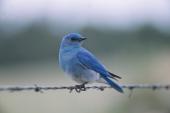
The thrushes are a family of small to medium-sized songbirds with unspecialized bills which walk or hop when feeding on the ground. They are classified either in the Family Turdidae, with about 330 species worldwide, or merged with the Old World flycatchers in the Family Muscicapidae, with about 450 species. Their plumage tends to be browns, although some, such as the bluebirds, have blues or rusty reds in their plumage. The males are more brightly coloured than the females and the young have spotted breasts. They are birds of wooded areas, particularly along the edges. Many have complex songs and are part of the “dawn chorus.” Saskatchewan has ten of the twenty-eight species which occur in North America. They are all migratory. Lorne Scott and Diane Secoy
The most familiar member of the family is the American Robin (Turdus migratorius) which breeds throughout the province. This chestnut-red breasted bird has benefited from settlement and the planting of deciduous trees in either the grasslands or the boreal forest regions. Four members of the genus Catharus are regularly found in the province. The cinnamon-brown Veery (C. fuscescens), with its deep flutelike call, is a fairly common breeding bird in the aspen parklands and wooded areas of the grasslands settlements. Swainson's Thrush (C. ustulatus) breeds in the aspen parklands and into the boreal regions; it is a common transient further south. The very similar Gray-cheeked Thrush (C. minimus) is a less common transient in the south and a rare summer resident in the boreal region; its main breeding grounds are further north. The Hermit Thrush (C. guttatus), another small brown thrush with light breast spotting is most recognized by the male's distinctive territorial song. It is a fairly common breeding bird in the boreal region and an uncommon transient further south. The Wood Thrush (Hylocichla mustelina), with bright brown spots on the white chest and belly, is a rare transient species from its breeding grounds in the eastern forest region.
Two hole-nesting bluebirds (genus Sialia) occur in the province. The Eastern Bluebird (S. sialis), with its blue head and back and chesnut belly, breeds in the eastern parklands region. Once more widely spread, it declined after the aggressive hole-nesting European Starling came into the province in the 1940s. The Mountain Bluebird (S. currucoides), in which the male is a uniform aquamarine, nests sporadically throughout the grasslands and into the southern boreal forest. Both species nest in nature in holes in dead trees or snags. The provision of nestboxes for bluebirds is a common sight along many roads in the grasslands as attempts are made to increase these native species. The nest boxes also provide space for Tree Swallows, another species which has suffered from competition from the invading starlings and House Sparrows.
Two western species are transient. Townsend's Solitaire (Myadestes townsendi) is an uncommon winter resident in a few regions of the south, with one breeding record in the Cypress Hills. The Varied Thrush (Ixoreus naevius) occurs sporadically in the south, usually in the fall.
Christian Thompson